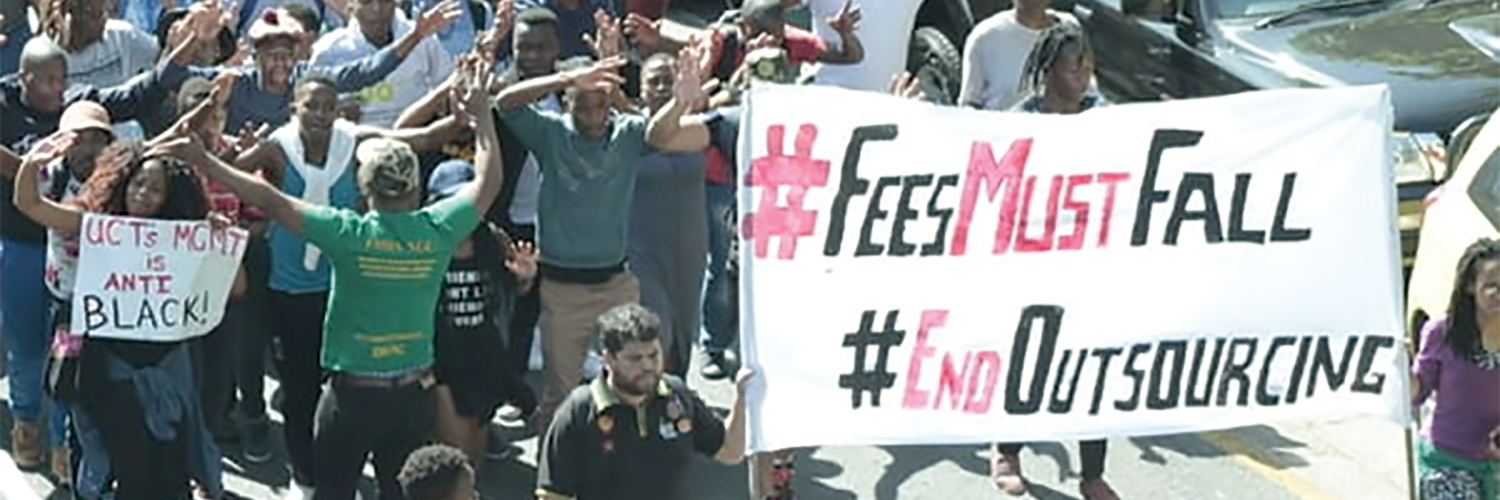LEGACY: Has “the Fees Must Fall” movement faded into history while higher education remains in crisis…
By Tshepo M Moloi
Dear fellow #FMF fallists, this is an open letter to you as I reminisce about colonial bonds, that have and continue to haunt education in the colony of South Africa.
There has been a common agreement from the beginning of the 1990s that South Africa’s higher education structure is stuck in a crisis, both architecturally and philosophically. A major cause of the current problem in higher education is the refusal to address the legacy of empire, colonialism, apartheid, and, in recent years, the neoliberal ideology that has influenced and is shaping the fundamental ontology and epistemological perspectives of the field.
The rise of #FeesMustFall, #RhodesMustFall, the Black Student Movement, the #OpenStellenboschCollective, and lately the #Asinamali demonstrations served as an alarming indication that neoliberal kinds of colonialism continue to exist and seem firmly established in the higher education system more than 30 years after the collapse of institutionalised apartheid.
During the #RhodesMustFall demonstrations in Cape Town in 2015-2016, a few of the many eye-catching signs were a statement that read, “Our caregivers were sold visions in 1994-we desire a refund,” denouncing the then-Mandela and Tutu misconception of South Africa as the “rainbow people of God” and demonstrating the nation as a flopped ideological test that was unable to live up to the beliefs of millions of black individuals who remain enslaved in fundamental and intergenerational poverty.
NATIVE EDUCATION
The implementation of apartheid in South Africa is one of the gloomy results of European colonisation. As a result of adopting this system, the minority white administration in South Africa ensured that people of different races had fewer legal protections and fewer economic possibilities than whites. South Africa’s diverse population saw the effects of apartheid in many ways, including socially, economically, and politically. Apartheid’s policy of racial segregation was central to its ideology. Education was one area of civilization that was profoundly impacted by this approach. Former President Nelson Mandela called the apartheid school system “a crime towards humanity” for its racial segregation and discrimination.
Following the National Party’s rise to the presidency in 1948, which advocated apartheid, a system of segregated and disparities schools was put into place. The educational system of the Bantu was introduced to the African populace (Mao et al., 2019, p.7). Both the quality of instruction and the prominence of Afrikaans in the curriculum were markedly lower for black students than for white students. F. Verwoerd, apartheid’s Minister of Native Affairs, confirmed that education was crucial to dominance by saying he would improve native education once he gained power so that natives would be instructed from a young age that equal treatment with Europeans was not an option for them (Masinire, 2020, p.32).
According to Article 29 of the Universal Declaration of Human Rights, schooling should be dedicated to the complete growth of the individual’s character and to foster a culture of upholding the rights of others and essential liberties (Mao et al., 2019, p.12). The Apartheid regime’s attitude to education ran counter to this proclamation.
As a result of its overtly racist regulations, the Apartheid regime exacerbated existing gaps in access to education. In 1952, Congress passed the Bantu Education Act, which mandated that Black children receive a curriculum designed to keep them uneducated and permanently mired in the underclass of society (UCT) (Gallo, 2020, p. 22). By restricting students of colour’s ability to pursue higher education, this strategy served to exacerbate racial disparities. Apartheid laws hampered students’ capacity to learn in other ways as well as those related to course material.
According to Netshakhuma (2019, p. 13), White children had to attend school until the age of 16, Asian children until 15, and Black children until 13. The education of white children was also offered at no cost to their families. However, nearly all black schools charged significant fees, even at the elementary level, making it difficult for lower-income black families to afford quality education for their children.
Educators have always had a vested interest in helping their students become more productive members of society. In contrast to this norm, the apartheid system provided the sole educational system across the globe aimed at limiting the productiveness of its students in the country’s economy through low and subordinate duties as defined by Brookes. It’s obvious that the less schooling someone has, the fewer opportunities they will have in life. Since people of other races were unable to get the education necessary to fill higher-paying positions, those jobs were kept for whites. The leadership of South Africa made an effort to provide natives with schooling designed to train them as factory workers. As a result of being denied education on a level with white South Africans, those not classified white were unable to participate in the country’s economy during the apartheid-era (Brown, 2020, p. 56).
BUDGET GAP
In 1960, UNESCO noted that due to racial prejudice in schooling, only a small percentage of individuals in South Africa had access to higher education, leading to a persistent scarcity of top-level workers in the fields of science and technology (Castelo n& Ágoas, 2021, p. 8). Eliminating these rules in the post-apartheid period was the appropriate move toward achieving social justice because they guaranteed that the content and quantity of education reinforced social inequities.
There was also a noticeable budget gap in the educational system. Africans, Asians, Coloureds and Whites all received their distinct forms of education so that they could better comply with the idea of “separateness.”
While 96 percent of educators in white schools held credentials, only 15 percent of educators in black schools did (Masinire, 2020, p.37). For instance, there were notable distinctions in how educators of different ethnicities were prepared for their roles. In 1949, the governing body of South Africa formed a commission charged with developing new methods of educating children of different races (Gallo, 2020, p. 17). Curricula and course requirements were to be modified to better suit the government’s goal of making those not classified white conform to the competitiveness in the labour market.
In every country, the primary goal of schooling is to train students for the jobs of the future. Blacks and other members of South Africa’s minority communities provided White South Africans with a source of inexpensive workforce during the apartheid era. Providing a large pool of workers for the country’s expanding economy was, thus, a primary goal of Bantu schooling.
Consequently, non-white schools’ academic expectations were artificially lowered to conform to the distinct requirements of various industries; for Blacks, this meant preparing them for a future career as unskilled labourers. The amount spent on white students was significantly higher than that of an ordinary African student.
Private schools in South Africa were supported financially by the state before apartheid. The Bantu Education Act not only lowered educational standards by cutting funding to religious schools, but it also shut down other academic establishments (Gallo, 2020, p. 24).
As reported by Netshakhuma (2019, p. 14), the funding cuts had the greatest effect on Black pupils because so many Black families relied on church schools to provide for their children’s education.
Closing institutions that educate Black students is the greatest kind of scholastic discrimination and injustice, even if the authorities justified their decisions based on the separation of church and authority. Inequalities in getting into higher education are a direct result of policy and financing inequities in schools Netshakhuma (2019, p. 17) data shows that of South Africa’s nine institutions, four taught exclusively in Afrikaans, one taught exclusively in English, and the remaining five practiced some form of racial segregation.
Also, no grants or scholarships were available, and no financial institutions would extend credit to people of colour. If a kid managed to make it beyond working-class teaching taught by unqualified educators in crowded learning environments, they nevertheless encountered financial obstacles to reaching their full academic potential. As a consequence of the funding crisis, salaries for educators were severely reduced in many African countries. Because of this, not enough qualified individuals in Africa entered the teaching profession, and, thus, schools across the continent suffered from teacher shortages.
As a result of this, black South Africans experienced a greater rate of dropping out and worse educational attainment than white South Africans. According to Iredale (2021, p.16), the high price of a college education is the main cause of students dropping out or never enrolling. As a result of a lack of resources, particularly in the form of money, black communities often had to make do with sub-par educational facilities. Financial limitations also significantly impeded efforts to expand educational infrastructure.
INADEQUATE RESOURCES
The fundamental goal of African schooling was to enhance primary school enrolment and literacy rates. As a result, the government advocated for smaller class sizes in elementary schools that would place greater emphasis on the tool subjects. However, beginning in 1957, government agencies stopped providing funding to private educational institutions serving Africans, making it difficult for black people to afford such an option (Gallo, 2020, p. 9). As of 1990, government entities spent up to four times as much on schooling for a white student as it did for an African student (Gallo, 2020, p. 22). Regardless of whites’ greater economic agency and greater standards of living, the corresponding cost of education was significantly greater for blacks. The governing bodies of South Africa understood the significance of schooling to the nation’s development.
However, the official approach of Apartheid had a significant impact on schools, and the African, Coloured, and Asian minority suffered greatly as a result. UNESCO found that the lack of adequate resources in African schools hampered the academic pursuits of ambitious African students, particularly those interested in the sciences. According to Iredale (2021, p.16), discrimination based on race was a hallmark of apartheid in South Africa, with whites being given preferential treatment when it came to educational opportunities. Particularly, black children were exposed to fewer possibilities for schooling, and those that were available were of lower quality. In South Africa, schooling was used as a powerful weapon to dominate and establish White Supremacy over the other ethnicities. Education under apartheid was created to increase European dominance. Abdi claims that the inhabitants of South Africa were culturally influenced with colonialism and apartheid schooling. All the above rumblings form part of flashbacks of a fallist, curious if #FMF was another thing that subsided into history. Bolekaja.
- Dr. Tshepo Mvulane Moloi is a Postdoctoral Research Fellow at Ali Mazrui Centre for Higher Education Studies, University of Johannesburg






